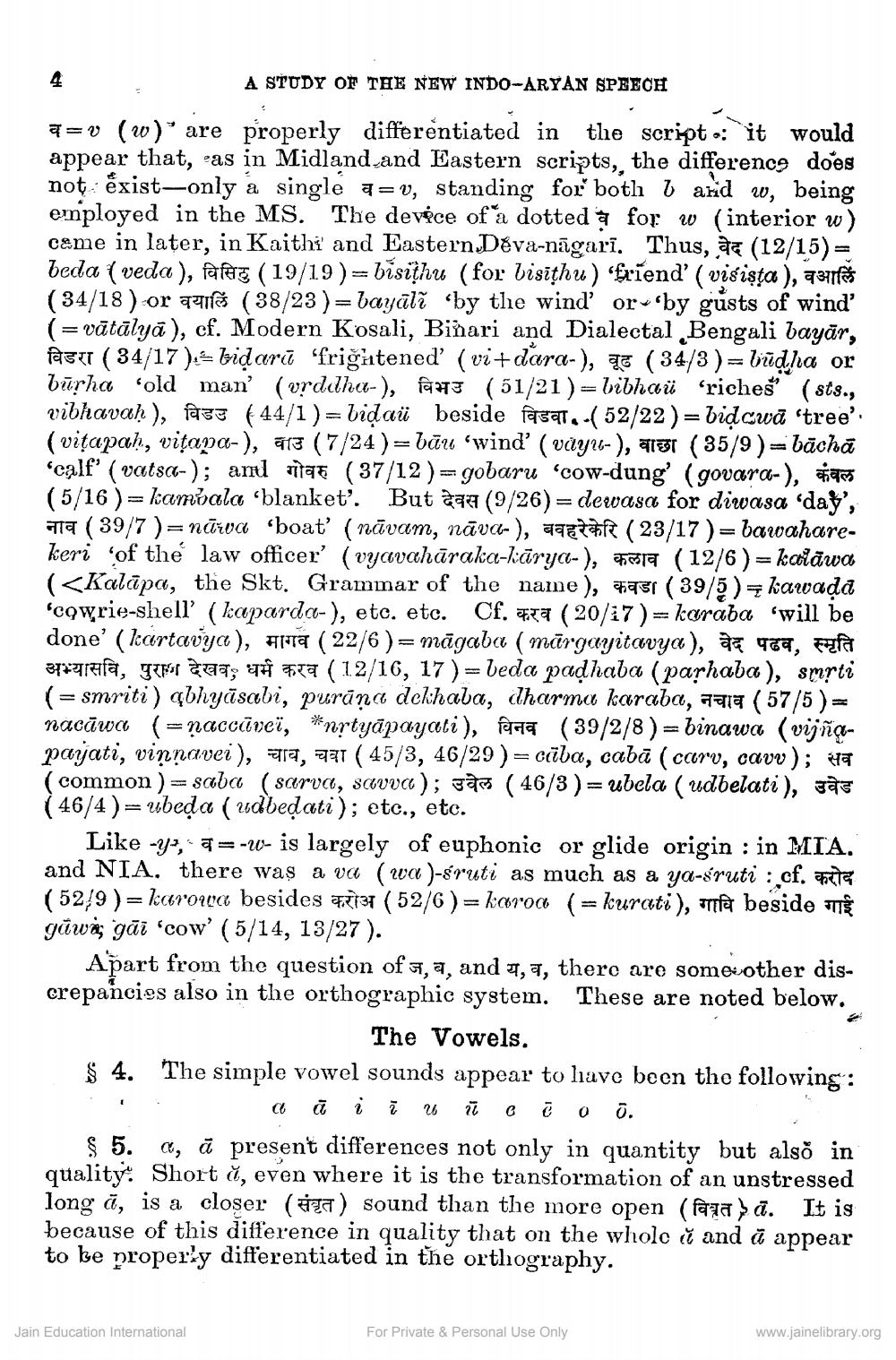________________
A STUDY OF THE NEW INDO-ARYAN SPEECH a= v (w) are properly differentiated in the script. it would appear that, "as in Midland and Eastern scripts, the difference does not exist-only a single arv, standing for both and w, being employed in the MS. The device of a dotted for w (interior w) came in later, in Kaithi and Eastern Déva-nagarī. Thus, a (12/15) = beda (veda), fafat (19/19 )= bisithu (for bisithu) 'friend' (višişta), 73111s (34/18 ) or qils (38/23 )=bayālī by the wind' or by gusts of wind (=vātālya), cf. Modern Kosali, Binari and Dialectal Bengali bayār, fazi ( 34/17).= liờarī friğhtened (vi+dara-), qe ( 34/3 )= liūdha or būrha 'old man' (vrddhu-), 3 (51/21 )=bibhaü 'riches' (sts., vibhavaḥ), às ( 44/1)= bidai beside fasata -(52/22 ) = biącwā 'tree' (vitapah, vitapa-), 913 (7/24)=bāu 'wind' (vůy26-), 4131 ( 35/9 )= bācha 'calf' (vatsa-); aml aa (37/12 )= gobaru 'cow-dung' (govara-), 475 (5/16 ) = kambala 'blanket'. But aaa (9/26)= dewasa for diwasa 'day',
ta ( 39/7 )=nārva 'boat (nāvam, nāvc), aartaf (23/17 ) = bawaharekeri of the law officer' (vyavahāraka-karya-), festa (12/6)= kaiāwa (<Kalāpa, the Skt. Grammar of the name ), 4951 (39/5) = kawada 'cowrie-shell (kapardo-), etc. etc. Cf. Fra (20/17)= karaba 'will be done' (kartavya), Ana ( 22/6 ) = māgaba ( mārgayitavya), a 469, Fala 37grafa, gemaa; T FT ( 12/16, 17)=beda padhaba (parhaba ), smrti (=smriti) qbhyāsabi, purāņa dekhaba, dharma karaba, 7717 (57/5) = nacāwa (=naccūveï, *nrtyāpayati), fena (39/2/8 ) = binawa (vijñopayati, vinnavei), ara, 791 ( 45/3, 46/29)= cūba, cabā (carv, cavv); pa (common)= saba (sarva, savva); sans ( 46/3)= ubela (udbelati), gas ( 46/4)= ubeda ( udbedati); etc., etc.
Like -y, 7 =-w- is largely of euphonic or glide origin : in MIA. and NIA. there was a va (wa)-śruti as much as a ya-sruti : cf. pts (5219 ) = karoua besides 1737 (52/6 ) = karoa (= kurati), mà beside ti gāwas gāi 'cow' (5/14, 13/27).
Apart from the question of , a, and 4, 7, there are some other discrepancies also in the orthographic system. These are noted below.
The Vowels. $ 4. The simple vowel sounds appear to have been the following:
a d i į u ū o 7 o . § 5. C, ā present differences not only in quantity but also in quality Short è, even where it is the transformation of an unstressed long ă, is a closer (aa) sound than the more open (fara bā. It is because of this difference in quality that on the whole ŭ and å appear to ke properly differentiated in the orthography.
Jain Education International
For Private & Personal Use Only
www.jainelibrary.org




